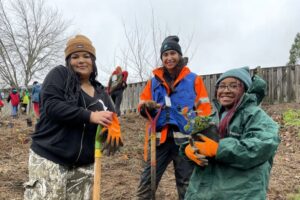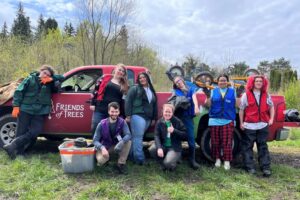Tag: POIC
Partner Spotlight: POIC
POIC is part of the 11-member coalition for our IRA Community Forestry Grant
On a sunny Saturday morning at Gateway Green Park, volunteers gathered to plant native plants on the wooded hillside of the park. Many of the volunteer crews were led by quiet but capable young folks from POIC.
Portland Opportunities Industrialization Center (POIC) connects high school youth with career training, including partnering with Friends of Trees. POIC students train as crew leaders and lead Friends of Trees plantings throughout the season. Gateway Green was this cohort’s fifth event overall this season, and second as crew leaders.
“This season is going great,” says Leigh Rappaport, Program Manager for POIC’s Natural Resource Pathway. “They’re a really committed group. They care about what they’re doing and are thoughtful about making sure volunteers are having a good time.”
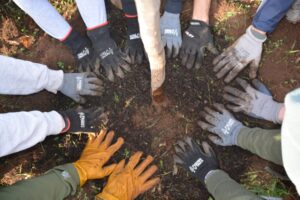
POIC is part of the 11-member coalition led by Friends of Trees that was awarded a $12 million Urban and Community Forestry Grant from the U.S. Department of Agriculture as part of the Inflation Reduction Act grants. The grant will fund community forestry work including tree planting, natural area restoration, post-planting care, community education, opportunities for direct community input and participation, and workforce training.
Part of the grant will help fund POIC’s natural resource training for five years. “Having this funding gives us room to breathe” Leigh says. “We can really focus on the program.”
Beyond that, Leigh looks forward to all of the partnerships that will grow out of this expansive and collaborative project.
“We’re excited to be part of a coalition being built from the ground up.”
Opening Doors With Youth Engagement
Our youth programming creates opportunities for young people to engage with nature
Getting youth excited about trees and green spaces is one of the best parts about our work. Friends of Trees engaged over 250 young people through youth programming this season!
“I had kids coming up to me and saying, ‘this is your job?!’” Green Space Specialist Kaitie Benedek says of her time working with students from CF Tigard Elementary School and Fowler Middle School. On five different planting days, 5th, 6th, and 7th grade classes planted native plants at Woodard Park and Dirksen Nature Park, which is adjacent to the middle school’s campus.
“We’d have classes of 25 at a time planting for one class period, so it was super fast,” Kaitie says. “So many kids got excited about planting, and about getting to contribute to this park right by their school. A lot of the kids even named their plants.”
Students from Cascade Education Corps (CEC) helped lead the plantings. CEC members are high school students following an alternative path to graduation by working on hands-on environmental projects. They spend three days per week out in the field working on restoration projects sponsored by other Tree for All partners, including Clean Water Services and Friends of Trees. With elementary, middle and high schoolers working together and people walking by in the park offering encouragement, the plantings at Dirksen and Woodard had a wonderful intergenerational feel to them.
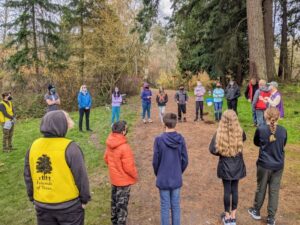
That spirit of connection and mentorship was present at Oregon Trail Elementary too, where forestry students from the Sabin-Schellenberg Center helped facilitate a full day of hands-on environmental education.
“Teachers and parent chaperones were very happy to get the kids outside,” says Green Space Specialist Meng Vue. “These kids weren’t afraid to get dirty.”
Students rotated through five different stations, learning to plant and mulch, decorating wood cookies, and learning about the local ecology with skulls, pelts, and pine cones. The goal was to show students all aspects of a healthy watershed and how planting native plants is an important component of that.
“When you get students involved in learning about the environment, appreciating the place and engaging with it, they’ll take those lessons home and share them,” Meng says.
Harrison Layer, another Green Space Specialist, echoes the importance of opening those doors through education. “When I was young, I saw nature as a big green blob. What are the ways to start to get curious?”
Harrison works closely with students from Portland Opportunities Industrialization Center (POIC), a nonprofit that connects high school youth with career training, including partnering with Friends of Trees. POIC students train as crew leaders and lead Friends of Trees plantings throughout the season.
“We had several students from last year come back this year,” Harrison says, “and it was great to see them grow into a leadership role. The mix of veteran and new students worked really well.”
Working with the POIC crew for an entire season means that you can see amazing growth in skills and confidence. “Everyone grew in their public speaking ability,” Harrison says. “By the end of the season, we had some students who demonstrated the confidence to represent their program through elevator pitches to large groups of volunteers at the beginning of our events.”
In addition to helping at plantings, POIC students got to go on several field trips, including mountain biking at Gateway Green, studying ecosystems at Whitaker Ponds Nature Park, and getting to know turtles and amphibians at Oaks Bottom Wildlife Refuge.
“One of the students at Oaks Bottom referred to this program as ‘unlocking’ new places for them to know and appreciate, much like a video game,” Harrison says. “I loved that!”
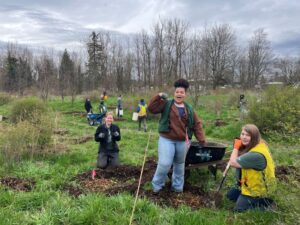
Trees Through The Years
Our inspection program connects volunteers to specific trees, visit after visit.
When Friends of Trees plants a tree, we don’t just wash the dirt off of our hands and move onto the next one. We return to inspect it, to prune it, replenish mulch, and make sure everything is looking good. These check-ups are for more than just to care for that individual tree—we’re also collecting data.
Most of the data that we track is for younger trees, Tiers 1, 2, and 3, according to their age, Tier 1 being trees that were planted in the most recent season. We do this to make sure each tree was planted properly, to track the survival rates of different species, assess the quality of the nursery stock, and keep an eye out for any trends we need to adapt to.
“We also do this to provide tree care advice to the tree recipient,” Haley says. If a tree fails for reasons beyond neglect, we can replace the tree or refund the recipient.
There’s another set of much older trees that we have been collecting data on: Tier Omega. Tier Omega trees were planted in the 2010 season, and we’ve been checking on a subset of them, the same exact subset, every year since they were planted. This has created a consistent and robust data set that can show the long term survival rates of older plantings.
In the summer of 2010, 486 Tier Omega trees were planted. Since then, just 45 trees from the Tier Omega subset have died or were moved due to development reasons. Now that these trees have settled, they’re less likely to be dramatically impacted by weather, so we have been seeing fewer dead trees with each round of inspections.
“There’s this great community feel to it,” Neighborhood Trees Senior Specialist Haley Miller says about the inspection program. “We have some Tier Omega inspectors who have been inspecting the same exact trees for eleven years now.”
Mike Ablutz is one of those Tier Omega inspectors who just keeps coming back. “Revisiting the same trees over several years is like checking in with young friends,” he says. “I love seeing how they are doing, how fast they are growing, and discovering the many ways that they are adapting to life’s challenges.”
When people sign up to get a tree from Friends of Trees, they can volunteer to be tree inspectors. They are assigned a Tier 1 route of about twenty trees, including their own, that need to be inspected twice each summer. Inspectors monitor things like weeds, mulch, and water. They measure the size of the tree and look for things like bark damage. “It’s a popular volunteer role,” Haley says. “People really enjoy visiting their trees.”
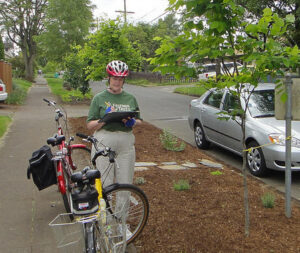
The tree inspection process is also one of the ways we engage our youth education programming at Friends of Trees. Our partnerships with the Portland Opportunities Industrialization Center and the Blueprint Foundation connect students and young people to urban forestry work. In the summer, they get to help with tree inspection, which continues to develop forestry skills like tree identification, and grow their connections to nature.
We are learning more and more that when a person feels a connection to a particular tree, it grows their connection to trees and nature more broadly. Our tree inspectors are proof of that.
“I often imagine how the young trees we plant will look when they are old,” Mike says. “Tier Omega inspections allow me to revisit specific trees and at least see how they are doing in their early years.” Hopefully Mike will get the chance to keep revisiting those trees for years to come.
Support our community partners
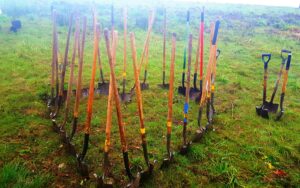
If you viewed any of our Earth Month events (here’s the playlist) you probably noticed that we often talk about partnerships and climate justice. Friends of Trees’ community includes partnerships with a number of truly impactful local organizations that work with underserved communities. Underserved communities experience the worst effects of climate change and our partnerships that help connect communities to the benefits of trees play an important role in achieving climate justice.
We have a special request of you: Support our community partners. Yes, Friends of Trees will always need you, but if we are going to achieve true climate justice we all need to support Black, Indigenous or People of Color (BIPOC) organizations that are part of the movement to ensure equitable outcomes around trees and the urban canopy.
These organizations are Friends of Trees’ partners and need your support:
Asian Pacific American Network of Oregon (APANO): Uniting Asians and Pacific Islanders to achieve social justice.
The Blueprint Foundation: Uplift, educate, and support the development of black-identified youth and other communities of color.
Portland Opportunities Industrialization Center (POIC): Committed to the success of underserved youth and adults.
Wisdom of the Elders: Native American cultural sustainability, multimedia education and race reconciliation.
If you’d like to learn more about how Friends of Trees partners with these organizations visit our website here.
Thank you for supporting our work and the work of our partners, and for being a part of the Friends of Trees community.
Get to know our partner: POIC
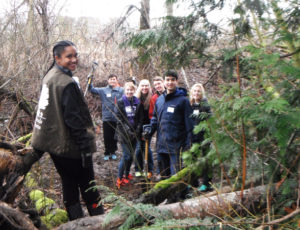
“Friends of Trees’ Crew Leader training program for POIC students creates a sense of community for our youth who are often disconnected from the greater community.” Leigh Rappaport, POIC Program Manager.
Based in North Portland’s Rosemary Anderson High School, Portland Opportunities Industrialization Center is a nonprofit that provides at-risk youth with high school education and connects them with career training, including partnering with Friends of Trees.
POIC students participate in a number of Friends of Trees activities, about 20 this planting season. Activities include classroom work on identifying plants and plant selection, but most of the work is outside. Friend of Trees trains POIC students in all aspects of a planting event: site-selection, site-prep, proper planting and staking. Additionally, POIC students train to be Crew Leaders, key leadership roles among FOT volunteers.
“The program creates a sense of belonging to something larger than themselves,” Leigh says. “The students feel that they’re doing something important by helping volunteers learn how to plant trees–and they’re also learning a lot about trees.”
Tree cheers for POIC!

